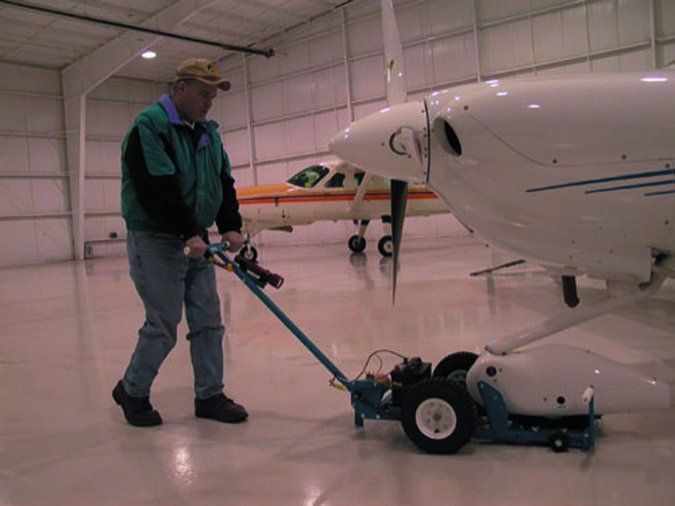It may have been that moment—after our feet had shot upward from the icy ramp while we were trying to pull the Cheetah out of the hangar and we lay there, watching the nosewheel roll toward our nether regions—that we came to like aircraft tugs. We think that an easily maneuverable tug that quickly hooks onto an airplane and can move it without strain reduces the risk not only of injury to the pilot but hangar rash to the airplane.
The good news is that there is a wide selection of tugs on the market that will move airplanes that interest us—6000 pounds or less. The bad news is that the size of the selection can make the right choice challenging.
We’ll run through what to consider when making a tug purchase and then outline what’s on the market. We’ll say up front that if you want the highest level of reliability, live where it gets cold in the winter and have electricity in your hangar, spending the extra money for a battery-powered electric tug makes sense. If you don’t mind taking care of the routine maintenance requirements of a gasoline engine and aren’t too worried about cold-weather starting, the internal combustion tugs are less expensive to buy.
When it comes time to select the right tug for your airplane, we recommend a conversation with the tug manufacturers to discuss your specific needs. Just because an advertisement says a tug will pull a 4000-pound airplane doesn’t mean it will do so up a sloping ramp, over a lip or break in pavement or across sliding door tracks.
A tug exists to make an aircraft owner’s life easier. If the tug won’t easily handle your airplane in the conditions peculiar to your hangar environment—including snow and ice—you are not going to be happy and you risk damaging your airplane in a hangar-rash event. Aircraft tugs are very much “you get what you pay for” products.
We’ve used tugs powered by gasoline engines as we’ll as corded and cordless electric tugs. As battery technology has steadily improved, we’ve found ourselves leaning toward battery-powered electric tugs for their convenience and a dislike for dealing with long electrical cords. We’ve also wished for an electric tug when we couldn’t start a gasoline tug on a cold day.
If you have electricity in your hangar, leaving most of the battery-powered tugs plugged in to their smart chargers should ensure no shortage of power, even when you want to move the airplane a few hundred yards to the fuel pump.
Battery Life
We were told a battery for an electric tug (other than the “power drill” tugs) should last for five to seven years although Terry Railing, proprietor of battery-powered tug maker Aero-Tow, told us that he has customers who reported battery life in excess of 11 years.
Not surprisingly, gasoline-powered tug makers are very sensitive to the need for reliability and ease of starting in cold weather and they have worked like mad to ensure cold starts—but they candidly admitted that they can’t make them as reliable in the cold as an electric tug.
Most of the tugs we looked at are actually powered tow bars, so they attach to the nose (or tail) wheel. The wheel itself is the pivot point so most tugs have to be lifted or pulled sideways to make a turn—and care needs to be taken to avoid exceeding nosewheel turn limits. If your airplane has nosewheel turn limits, disclose them when you speak with the tug manufacturer. Some tugs have optional casters to ease moving the tug when making a turn. Priceless Aviation Products 701 and 701L and Aero-Tow’s Lil Sherman have a swivel arrangement so it’s not necessary to lift or slide the tug to turn.
Some tugs lift the nosewheel off of the ground so is not necessary to pull or tilt the tug to make a turn. Those tugs can allow an exceptionally tight turning circle but can potentially side-load the nosegear if mishandled.
Most tug manufacturers will sell you tire chains for winter operation. They sound like a good idea; however, if your hangar floor is relatively smooth concrete, tire chains can turn your tug into a pig on ice—not to mention tearing up the pavement. We lean toward the inexpensive method of handling ice recommended to us by Aero-Tow’s Terry Railing: Keep a bag of kitty litter in the hangar and sprinkle it on the ice and snow for instant traction.
Despite advertising, there is no such thing as a “universal” tug. Some come close, but still need adjustments to brackets or bars to fit particular airplanes and some will not work on airplanes with nosewheel pants or on tailwheel airplanes. We repeat our recommendation: Talk to the manufacturer before ordering.
Finally, we were advised by some of the manufacturers that the prices quoted to us will probably ratchet upward significantly if the proposed tariff on steel takes effect.
Aero-tow
Some years ago Wisconsin-based Aero-Tow(www.aero-tow.com). switched over to purely battery-powered tugs. Owner Terry Railing told us that, because of reliability in operation, sales took off, especially in Alaska and to women. Aero-Tow offers two models that fall into our classification as suitable for under-6000-pound airplanes, the E200 and Lil Sherman. The tugs are described on the website; however, the suggested aircraft weights for each and the prices are not shown. That’s because Railing wants to speak with the potential buyer to find out what type of airplane is involved as we’ll as the environment in which the tug will be operating.
Railing also has a policy of selling each tug fully equipped—no options—because his experience has been that dissatisfied customers are the ones who didn’t buy enough tug. Each tug comes with the fork assembly and adapter appropriate to the airplane, a battery, charger, electronic speed control and lights.
Because of Railing’s experience with customers who had trouble assembling tugs, assembly of the E200 and Lil Sherman involves just installing one bolt. Each tug is built for the customer’s airplane. However, should the customer get a different airplane or sell the tug, a call to the factory is all it takes to purchase the correct components for the new airplane—or find out that the tug will work as is.
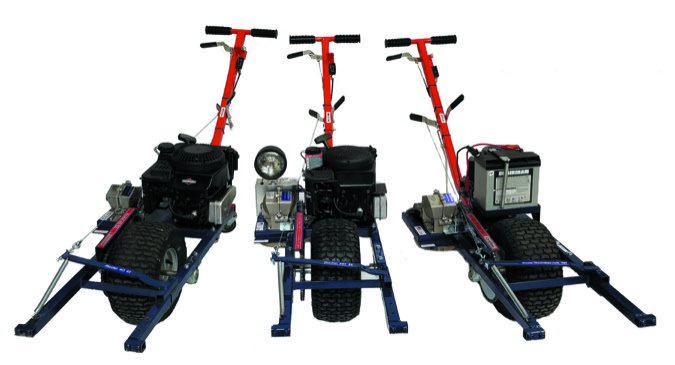
All Aero-Tow tugs have two driving wheels with a 24-volt electric motor that uses two 12-volt sealed batteries.
The $1500 model E200 (all prices for Aero-Tow were given to us as “ballpark” numbers) weighs 135 pounds, can be configured to tow just about any general aviation airplane—nosewheel or tailwheel—and puts out aboutone HP. The company describes its capabilities as “equal to the power of one person, struggling, to move the aircraft.”
The $3000 Lil Sherman puts out about three HP and has adapters that allow it to tow most general aviation airplanes up to 6000 pounds. It is described as allowing one person to easily move a single or twin. To maximize traction, its frame swivels to keep both driving wheels on the ground during turns.
Powertow
In the aircraft tug business for 40 years, with some 30,000 tugs in the field, Northwest Manufacturing(www.powertow.com). seems to be expanding its product line on a regular basis. Long known for its Briggs & Stratton piston-powered tugs capable of burning avgas or mogas, the company has aggressively moved into the electric tug world. As sales manager Gilbert May put it when we spoke with him, “It’s the wave of the future. The electric motor puts out more torque, there are fewer parts to break and it’s quiet so you can hear when someone yells that you’re about to hit a wingtip.” Nevertheless, May said that the company wasn’t
Dragger’s Nose-Dragger NDE-1 electric tug has two drive wheels and differential to make turning easier.
Left to right in upper photo: PowerTow’s gasoline-powered 40 EZ, Key EZ and electric ThunderVolt tugs. Aero-Tow’s Lil Sherman, below, swivels to keep both driving wheels on the ground when maneuvering.
convinced that it should put an electric tug on the market until it did some testing during an Idaho winter that included keeping the battery in a freezer all night and then subjecting the electric tug to a series of load tests on a bitterly cold morning.
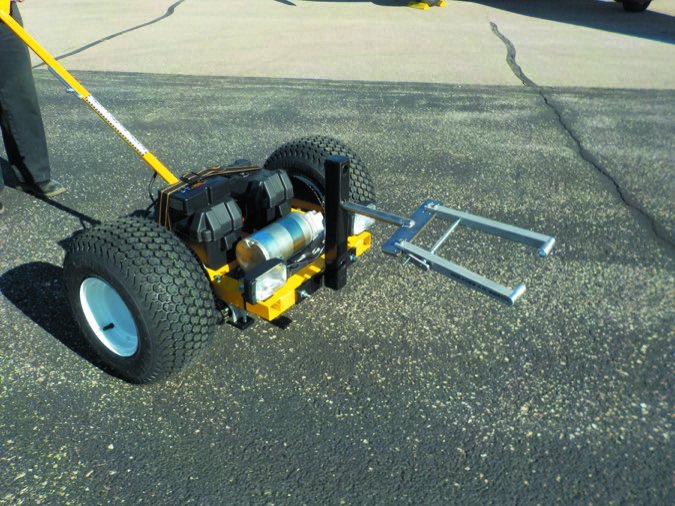
All of the PowerTow tugs have a single driving wheel and will attach to almost any nosewheel aircraft and to Scott tailwheels. With adapters they will work with some other tailwheels; check with the factory. The tug is we’ll balanced and, once disconnected from the airplane, can be rolled with one hand.
The user can affect the tire traction by pushing down on the handle of the tug. We used a PowerTow 40 EZ for eight years to move a Cessna T210 (the tug had been in use for several years before we were involved with it). We noted that the tire tread finally wore down enough that it would slip on a smooth concrete hangar floor; otherwise it worked we’ll to move the airplane on a sloping ramp and in snow and ice. Options available include tire chains and headlights.
Long the most popular of the PowerTow line, the $1899 model 40 EZ puts out 6.75 HP and is advertised as suitable for singles and light twins up to 6000 pounds “depending on conditions.”
At $2199, the Key EZ is the 40 EZ with options made standard as we’ll as a key start, 12-volt battery and charger.
With an 8.75-HP engine, the $2799 model 65 EZ is designed to move airplanes up to 7000 pounds. It has a larger frame and longer arms than its smaller siblings and casters to ease movement are standard. In speaking with PowerTow’s Gilbert May, he pointed out that he recommends the 65 EZ for light twins with longer noses, such as the Aerostar, because the smaller tugs, with shorter arms, require the user to stoop under the aircraft nose. He said the 65 EZ gets rid of that problem, letting the user stand upright where he or she can more clearly see the wingtips and tail—plus the extra power helps on sloping and contaminated ramps.
The ThunderVolt is PowerTow’s first electric tug in its single-wheel line. For $2399, it includes a 12-volt DC motor, battery and battery charger/minder. As with the 40 EZ and Key EZ, it is advertised for airplanes up to 6000 pounds.
PowerTow’s website indicates that a ThunderVolt was hooked up to an 8000-pound load and tested on a 10-degree F day. Pushing, it generated 500 pounds of wheel force and 350 pounds when pulling. They were unable to stall the motor; the tire would start to slide first.
Dragger
The Dragger(www.dragger.com). series of electric and gasoline tugs are for lighter aircraft on relatively flat ramps and hangars with minimal lips or door tracks. All have two drive wheels and are designed either for nosewheel or tailwheel airplanes—one size does not fit all.
The Nose-Dragger Dragger tugs have a distinct method of attaching to the aircraft—avoiding metal-to-metal contact. The tug is snugged up against the front of the nosewheel and then, by leaning over and moving a lever, a roller is snapped into place against the rear of the nose tire. This effectively cradles the nose tire, although it is not lifted off of the ground. The system accommodates wheel pants so long as there is at least a three-inch clearance from the ground.
If there is a hangar doorsill, lip or tracks, the website calls for you to measure its height. If it is one quarter of an inch or less, Dragger will sell you ramps to deal with the lip. If it is higher than that, the prospective buyer is instructed to call the company.
The $1595 Nose-Dragger Dragger NDG gasoline tug is advertised for aircraft up to 5000 pounds.
The 24-volt electric Nose-Dragger version, model NDE-1, is priced at $2195 and also advertised for aircraft up to 5000 pounds. It includes the battery and smart charger. We like that it has a twist-grip throttle and that its two driving wheels have a differential, making turning easier.
The Tail-Dragger Dragger tugs also have two driving wheels; however, they attach to the airplane by clamping onto the tailwheel and lifting it off of the ground. The operator moves the tug into position parallel to the airplane and adjacent to the port side of the tailwheel. The tug is then collapsed by retracting the caster on the back and then is slid sideways across the ground until the tailwheel is cradled by the midsection of the tug. The aft end of the tug is raised by lifting the handles. The caster extends and locks into position and the tailwheel is supported by the tug. We were impressed by the system.
The company still notes that hangar door sills can be a problem although our review of videos on the company’s website caused us to believe that the door sill issue is less of a problem for the Tail-Dragger tugs.
The gasoline Tail-Dragger Dragger, model TDG-6, is priced at $1595.
The electric Tail-Dragger Dragger, model TDE-1, has the same differential for its two-wheel drive system as the electric Nose-Dragger Dragger. It is priced at $2195. Both versions are rated for airplanes up to 5000 pounds “on a flat surface or a rain grade surface with a grade of no more than 1 to 2 percent.”
Airtug
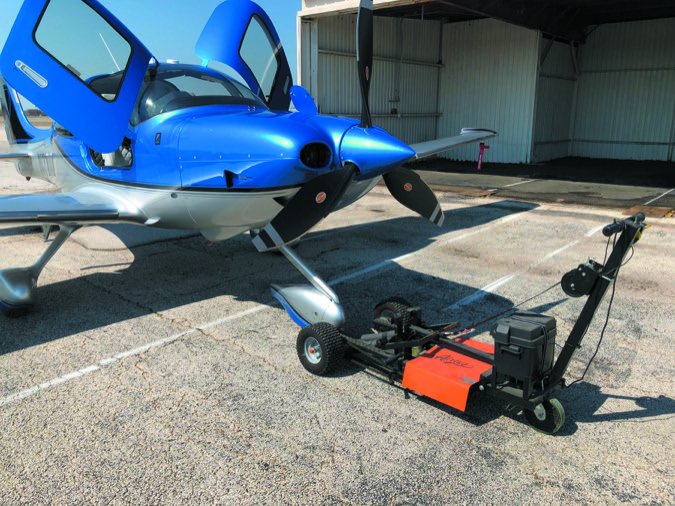
Airtug(www.airtug.com). is a sister company to Dragger and offers a line of more powerful tugs capable of moving larger airplanes in more demanding environments.
Naturally, after asserting that the tugs are capable of moving heavier airplanes than the Draggers, we note the exception: The $3195 model NFE-4 is an electric tug specifically designed for Cirrus aircraft and advertised for airplanes of under 4000 pounds.
The tug lifts the nosewheel off of the ground via a clever system in which a U-shaped tow bar is attached to the nosewheel (with or without wheel fairing). A strap is attached to the tow bar and a winch on the handle of the tug is cranked to pull the nosewheel onto a platform on the front of the tug. Another crank raises the platform above the ground.
The 24-volt system moves the airplane via an electric transaxle with differential driving two wheels. Speed is controlled using a thumb throttle. A rear caster balances the unit, so there is no lifting or sliding it sideways when maneuvering an airplane. The system includes two batteries and an onboard smart charger.
At $3795 the NFE-6 is an electric tug rated for airplanes up to 6000 pounds, particularly light twins. It is an electric tug with the same features as the NFE-4 but more power.
Priceless Aviation
Making electric tugs rated for moving airplanes weighing up to 4500 pounds on a flat surface, Priceless Aviation(www.pricelessaviation.com). offers two models that are advertised as optimized for moving aircraft safely in tight areas. Both are 24-volt units and have motors developing 400 watts. Each has a swivel connection between the two-wheel drive unit and tow bar so that the tug does not have to be lifted or tilted to make a turn.
The tow bar has what the company refers to as a universal adapter so that it can attach to any nosewheel airplane without the need of tools, although a buyer does have to identify the type of aircraft to be used—and whether it has wheel pants—when ordering a tug. We spoke with Scott Ake at Priceless and learned that they get calls from aircraft owners who are considering purchasing a used tug and want to know what is involved in setting it up for use on their airplane. Ake told us that it’s simply a matter of making sure the new tug owner has the right adapter for the airplane. If a different adapter is required, the price is $125.
The $2595 model 701E uses two 12-volt sealed lead acid batteries with a battery life of approximately one hour. It is collapsible for compact storage.
The model 701EL sells for $3245 and uses two 12-volt sealed dry-cell batteries with an estimated life of 90 minutes when fully charged. It is not collapsible.
The Airtug NFE-4 electric tug was designed for Cirrus aircraft.
Select Tugs For Aircraft Under 6000 Pounds Compared | |||
COMPANY, MODEL AND POWER | AIRCRAFT WEIGHT | PRICE | COMMENTS |
| aero-tow e200 (electric) aero-tow lil sherman (electric) | not specified under 6000 pounds | $1500 $3000 | “Equal to the power of one person, struggling, to move an aircraft.” Swivel frame keeps both driving wheels on the ground. |
| Powertow 40 EZ (gasoline) powertow key ez (gasoline) powertow 65 ez (gasoline) powertow thundervolt (electric) | under 6000 pounds under 6000 pounds under 7000 pounds under 6000 pounds | $1899 $2199 $2799 $2399 | single wheel, attaches to almost all nosewheel airplanes. Key start version of the 40 EZ. Higher power, larger frame, better for long-nose twins. Electric version of the 40 EZ. |
| Dragger Ndg (gasoline) dragger nde-1 (electric) Dragger tdg-6 (gasoline) dragger TDe-1 (electric) | under 5000 pounds under 5000 pounds under 5000 pounds under 5000 pounds | $1595 $2195 $1595 $2195 | nosewheel airplanes only, hangar doorsills may be a problem. Electric version of the NDG, but with differential for the drive wheels. Tailwheel airplanes only; the tug lifts the tailwheel off of the ground. Electric version of TDG-6, but with differential for the drive wheels. |
| Airtug nfe-4 (electric) Airtug NFE-6 (electric) | under 4000 pounds UNDER 6000 POUNDS | $3195 $3795 | Designed for Cirrus models; tug lifts nosewheel off the ground. More powerful version of the NFE-4. |
| priceless 701E (electric) priceless 701EL (electric) | under 4500 pounds under 4500 pounds | $2595 $3245 | One hour battery life, two-wheel drive, collapses for storage. Longer battery life (90 minutes) version of the 701E, not collapsible. |
| minimax electric drill line | under 4000 pounds | $1400-$1700 | Suitable for level surfaces; may have trouble with hangar door lips. |
| Robotow 28vl (electric) robotow 24sl (electric) robotow Mooney 28vl (electric) Robotow Millenium (electric) robotwo lancair 28vl (electric) | under 4000 pounds under 4000 pounds under 4000 pounds under 4000 pounds under 4000 pounds | $1445 $1476 $1492 $1255 $1492 | Can move a Cessna 182 about 1000 feet on a charge. Can move a Beech Baron about 600 feet on a charge. Works only on Mooney aircraft. Not a battery unit, comes with 100 feet of electrical cord. Works only on Lancair aircraft. |
Both tugs are capable of handling tailwheel airplanes, although a longer clamp arrangement may be needed. In use, directional control is via a rocker switch and the throttle is lever-operated. Options include chains and ball hitch attachment for moving campers, boats and trailers.
Minimax
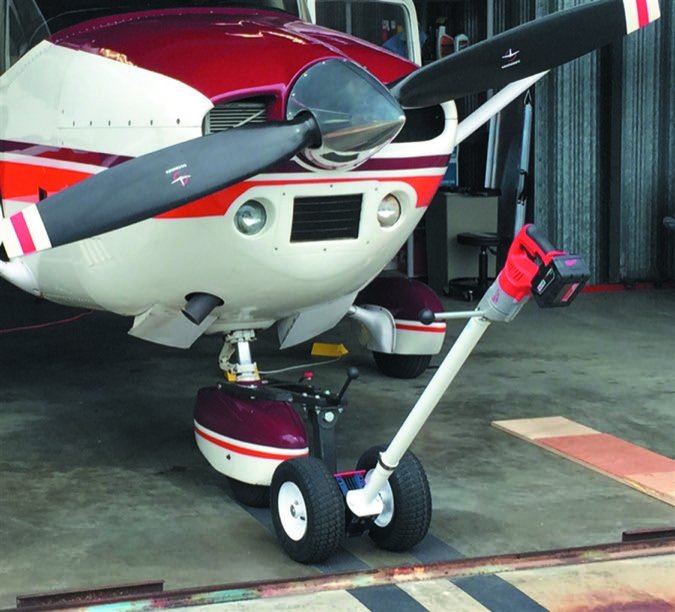
One of two manufacturers making use of what is effectively an electric drill to power a tow-bar tug, Minimax Aircraft Tug(www.minimaxtugs.com). offers a seemingly endless line of units. Using a 28-volt lithium-ion power system, the tugs are advertised for moving airplanes weighing under 4000 pounds on level surfaces. We note that when moving an airplane with a power-drill tug the aircraft tires must be properly inflated or rolling friction can overpower the tug.
Each tug consists of a power drill at the operator’s end, a handle, drive shaft, transmission and attachment to the airplane. The transmission either turns two small “tractor tires” along the ground or a wheel that presses against and turns the nosewheel tire.
On a dry, level surface the nosewheel drive works a little better because of mechanical advantage. If the ramp is contaminated by rain, snow or ice, performance drops off significantly. Both drive systems have some difficulty with sloping ramps and hangar door lips. We saw prices ranging from $1400 to $1700. There are a number of options including spare batteries and traction tape for smooth hangar floors.
Robotow
In business for over 50 years and currently offering battery-powered and corded electric towbars, Robotow(www.robotow.com). units are designed for nosewheel airplanes without wheel pants. All models use a knurled wheel that presses against and drives the nosewheel—it is advertised as non-slip, something important when the tire is wet.
The battery models vary in battery chemistry, size of the battery pack and the operating voltage.
The $1445 28VL uses a 28-volt lithium-ion battery. Robotow says it will move a Cessna 182 1000 feet on a flat ramp on a single charge.
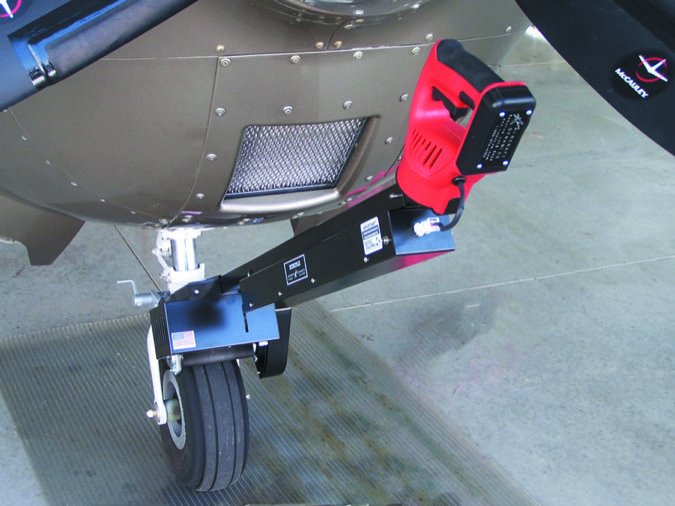
At $1476, the more powerful 24SL has a detachable 24-volt lead acid battery and is advertised as able to move a Beech Baron 600 feet on a flat ramp on one charge.
The Mooney-specific 28VL is priced at $1492 and is the only Robotow model advertised as working on Mooney aircraft.
The fourth model is the $1255 Millennium, a 120-volt corded unit that comes with 100 feet of cord—more than adequate in our experience.
There is also a Lancair-specific 28VL available for $1492.
Each model requires an adapter for the type of airplane to be used—it is included in the price.
Conclusion
For flat ramps, no hangar lips and short distances, we think a power drill tug may be satisfactory—although the price may tempt buyers who need more tug to buy one and be dissatisfied.
For owners with electricity in their hangars, other than flat surfaces to navigate and who need cold-weather reliability, we think battery-powered electric is the way to go.
The price of admission for a robust tug, muscular enough to handle a big single or light twin, looks to us to be about $3000.
Where cold starts aren’t much of a problem or there’s no electricity in the hangar, we think the old standby PowerTow 40 EZ gasoline tug is a reasonably priced workhorse.
Minimax power drill tug on a Cessna 182, above. The Robotow 24SL, below.
Ac Air’s Remote-control Tugs
Chino, California-based AC Air Technology attracted attention at Sun ‘n Fun this past spring with its TrackTech remote-control tugs. We took a good look at several models and are impressed with build quality and materials. No, these tugs aren’t inexpensive.
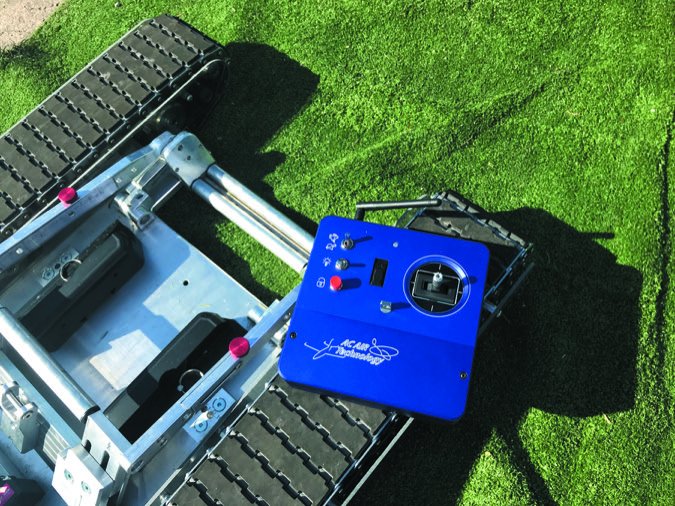
First, the tech. AC Air’s tugs work with a transmitter/control box (shown in the inset to the right) on the 2.4 GHz radio spectrum. Naturally, there’s a concern of interference—and uncommanded control inputs to the tug—but AC Air says its FHSS, for frequency hopping spread spectrum, operates 100 percent interference free. With over 800 tugs in the field, the company says there has never been a signal intercepted or a runaway tug. If the tug loses the signal from the remote, it shuts down.
Choosing the right TrackTech model depends partly on the weight of the airplane. Its lower-end model can tow up to 2500 pounds, while the flagship model can tow 20,000-pound aircraft. AC Air owns a patent on the rubber track technology built into the tug, making it perhaps the only production tug you’ll see on tracks. Pricing ranges from $2750 to $10,000.
The general idea of driving a tug remotely is to have the freedom to walk around the aircraft while inching it in to tight spaces without needing a wing walker. Ever have the sickening feeling that follows a hangar crunch? We have, and this technology reduces the risk, but only if you drive it properly. To do that, the remote control needs to be intuitive and simple and based on our use, it is. The lanyard-equipped remote has what’s called a Hall effect joystick, which is controlled via sensors rather than with potentiometers. That means longer life and precise control input.
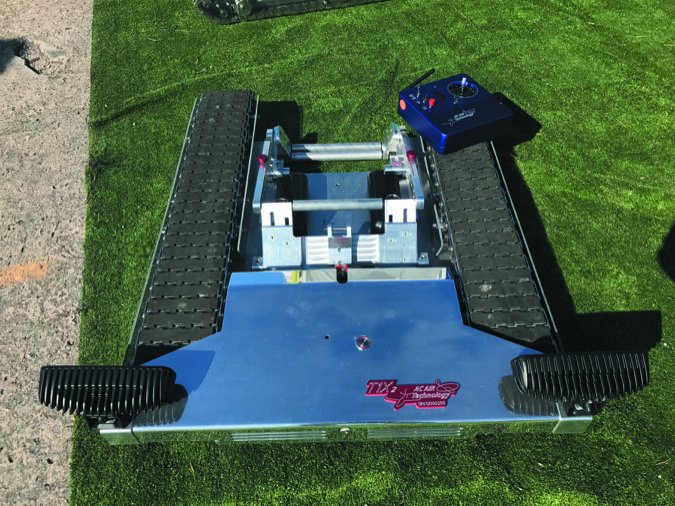
The joystick has forward, back, right and left positions, which move the tug in any of those directions. There’s an on/off switch, plus a three-position speed switch for slow, medium and fast. There’s also a release button, for releasing the airplane out of the cradle. There’s no bending down to strap/unstrap the nosewheel (or tailwheel) from the cradle. It auto-loads and auto-releases. If the tug has optional LED lighting, there’s a switch for turning them on or off. The lights (there are two of them mounted to the front of the tug) aren’t so much for use as headlights, but instead as a way to spot the tug in the dark. Like the rest of the tug, the lighting is high quality. This factory-installed option is $250.
The second-generation TrackTech T1X2 for non-wheel fairing and fairing-equipped airplanes with a max gross weight of 8000 pounds has a 24-volt rechargeable LiFe P04 lithium-ion battery. Charge time is two hours for continuous 30-minute usage. That’s a long time to be moving an airplane—plenty of endurance. It’s a strong battery, powering the tug’s dual high-torque motors. The battery should last from five to seven years. The electronics, batteries and motors on the TrackTech tugs are easy to get to, housed underneath a hood on the front of the tug.
Weighing 77 pounds, the T1X2 tug has a maximum speed of 160 feet per minute, or roughly 2 MPH. AC Air suggests the T1X2 for towing up steep inclines and challenging hangar door tracks. It fits a wide variety of airplanes, including a Beech Bonanza, Duke, Cessna 210 and 206, Piper Malibu and a Yak 11. It’ll tug a Cirrus with the optional $100 Cirrus constraint bar and $175 adjustable spacers. The price: $4950, not including the bar, spacers and freight. There’s an option for studded tracks for use in ice and snow. It’s an extra $420. AC Air says the standard tracks should last roughly two years with typical use.
The $6750 TrackTech T1.5 can tug airplanes up to 10,000 pounds and with a tire diameter up to 21 inches. Example applications include the Cessna Mustang light jet, Cessna Caravan turboprop single and Socata TBM series. The T1.5 has a Lazy Susan platform. This enables you to rotate the tug underneath of the tire—a safeguard against exceeding the steering limits of the nosewheel. The tire rolls up onto the platform and the weight locks it in place. It won’t move until you press the release button on the controller, enabling the platform to rotate 360 degrees underneath the wheel.
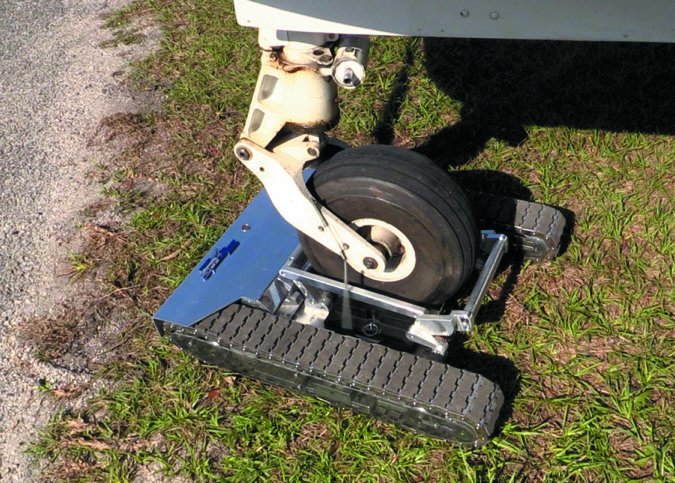
AC Air says that much of the typical maintenance (not much more than battery changes, really) can be performed right on site. Other repairs require crating and shipping the tug to AC Air’s facilities in California.
The company’s website(www.acairtechnology.com). has a good utility for matching the airplane to the correct tug. The tugs work with a wide variety of models. For example, clicking the Mooney M20 tab suggests the $4950 T1X2 model. For a Cessna 172, the $3595 T1V2 will do. If you have wheel pants, you’ll need the $65 tire height spacer, which raises the tire up in the cradle.
The tugs have a one-year parts and labor warranty. Contact AC Air Technology at 855-884-7222 .

